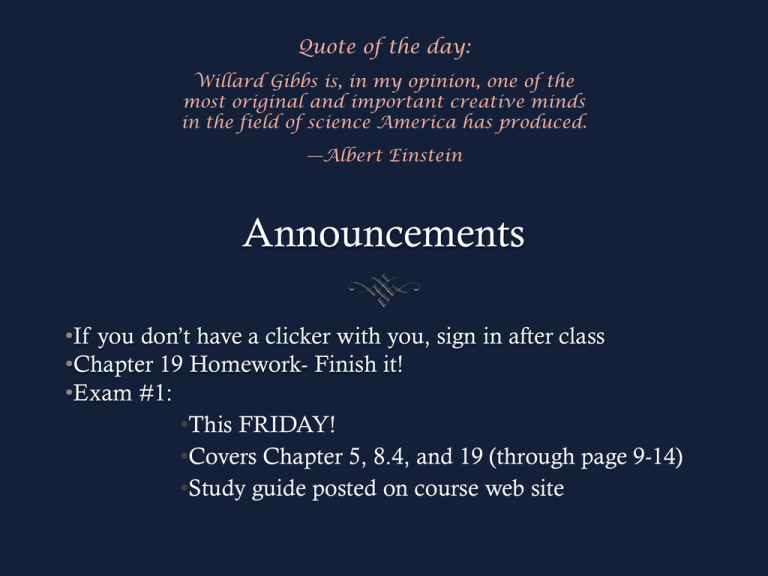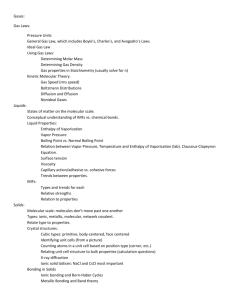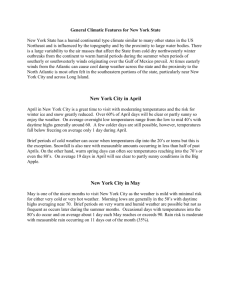CHEM 112 General Chemistry 2
advertisement

Quote of the day: Willard Gibbs is, in my opinion, one of the most original and important creative minds in the field of science America has produced. —Albert Einstein Announcements •If you don’t have a clicker with you, sign in after class •Chapter 19 Homework- Finish it! •Exam #1: •This FRIDAY! •Covers Chapter 5, 8.4, and 19 (through page 9-14) •Study guide posted on course web site Gibbs’ Free Energy Gibbs’ Free Energy: G = H - TS (All variables are in terms of the system) When G is negative, reaction is favored. When G is positive, reaction is disfavored. When calculating G, be careful with enthalpy units! At 25°C, is this reaction spontaneous? N2(g) + 3 H2(g) 2 NH3(g) G = H - TS 2 Fe2O3(s) + 3 C(s) 4 Fe(s) + 3 CO2(g) H = +468 kJ What is G at 25 oC and at 1000 oC? S = +561 J/K Temperature Domains and Reaction Favorability H + + S - - 2 Fe2O3(s) + 3 C(s) 4 Fe(s) + 3 CO2(g) H = +468 kJ S = +561 J/K In what temperature range will this reaction be favored? High or low? What temperature? At what temperature is this reaction spontaneous? (favored) CaCO3(s) CaO(s) + CO2(g) H° = +178 kJ S° = +161 J/K 25% 1. 2. 3. 4. 25% 25% 2 3 25% High temperatures Low temperatures All temperatures No temperatures 1 4 At what temperature is this reaction spontaneous? (favored) C(s) + 2H2(g) CH4 (g) H° = -74.80 kJ S° = -80.08 J/K 25% 1. 2. 3. 4. 25% 25% 2 3 25% High temperatures Low temperatures All temperatures No temperatures 1 4 At what temperatures is this reaction spontaneous? (favored) N2(g) + 2O2(g) 2NO2(g) H° = +66.36 kJ S° = -121.77 J/K 25% 1. 2. 3. 4. 25% 25% 2 3 25% High temperatures Low temperatures All temperatures No temperatures 1 4 Free Energy vs. Temperature Reaction 1 Reaction 2 Reaction 3 550 575 600 625 650 675 700 725 750 775 800 825 850 875 900 925 950 975 1000 1025 1050 1075 1100 1125 1150 1175 1200 1225 1250 468.00 0.56 G 159.45 145.43 131.40 117.38 103.35 89.33 75.30 61.28 47.25 33.23 19.20 5.17 -8.85 -22.88 -36.90 -50.93 -64.95 -78.98 -93.00 -107.03 -121.05 -135.08 -149.10 -163.13 -177.15 -191.18 -205.20 -219.23 -233.25 -80.08 0.07 G G -118.58 -120.33 -122.08 -123.83 -125.58 -127.33 -129.08 -130.83 -132.58 -134.33 -136.08 -137.83 -139.58 -141.33 -143.08 -144.83 -146.58 -148.33 -150.08 -151.83 -153.58 -155.33 -157.08 -158.83 -160.58 -162.33 -164.08 -165.83 -625 -0.65 G -267.50 -251.25 -235.00 -218.75 -202.50 -186.25 -170.00 -153.75 -137.50 -121.25 -105.00 -88.75 -72.50 -56.25 -40.00 -23.75 -7.50 8.75 25.00 41.25 57.50 73.75 90.00 106.25 122.50 138.75 155.00 171.25 187.50 G as a Function of Temperature Reaction 1 Reaction 2 Reaction 3 300.00 200.00 ΔG (kJ/mol) H S T 100.00 0.00 -100.00 -200.00 -300.00 550 650 750 850 950 Temperature (°C) 1050 1150 1250 Free Energy of Formation: Only used at 25 oC 2 BaO(s) + C(s) 2 Ba(s) + CO2(g) Exam #1 Review Exam #1 Review Exam #1 Review Exam #1 Review Chapter 11 Intermolecular Forces and the Liquid State Review: Bonding When atoms stick together, that’s bonding. Why do Covalent Bonds Form? Electrons on one atom attracted to nucleus of other atom Nucleus on each atom repels other nucleus Electron on each atom repels other electron If new attractions > new repulsions, then a bond forms Determining Molecular Geometry Valence Electrons Lewis Structure Electron-Pair Molecular Geometry Geometry Chapter 11 Properties of Liquids and Solids Formula Lewis Structure Electron Geometry Molecular Geometry Polarity Properties Intermolecular Forces What happens when water boils. Draw pictures. Bonding vs. Intermolecular Forces (IMFs): Where do IMFs come from? Types of forces between molecules: Intermolecular Forces (IMFs) Ion-Dipole Forces: Between dissolved ions and polar molecules Enthalpy of hydration: Trends: Dipole-Dipole Forces: Between polar molecules Trends: Dipole-Induced Dipole Forces: Between polar and nonpolar molecule Trends: Induced Dipole-Induced Dipole Forces: Between nonpolar molecules Trends: Hydrogen Bonding: Molecules with F-H, O-H, or N-H bonds Hydrogen Bonding: Properties of water Hydrogen Bonding: Properties of water More on Boiling Points and Hydrogen Bonding Identifying IMFs Relative Contributions of Different IMFs Properties of Liquids • Vapor Pressure (volatility) • Boiling Point • Enthalpy of Vaporization • Viscosity • Surface Tension Molecular interpretation of vapor pressure and boiling. Enthalpy of vaporization: Clausius-Clapyron Equation: Vapor Pressure, Hvap, and T Graphical Method of Determining Enthalpy of Vaporization Example 2. What is the mass of water in the air in this lecture hall? 14 m x 5 m x 17 m T = 22 oC Humidity = 43% Example 3. A 1-L flask of air is at 30 oC and relative humidity of 68%. The flask is put in a freezer and the temperature decreases to 5 oC. What happens? Surface Tension






